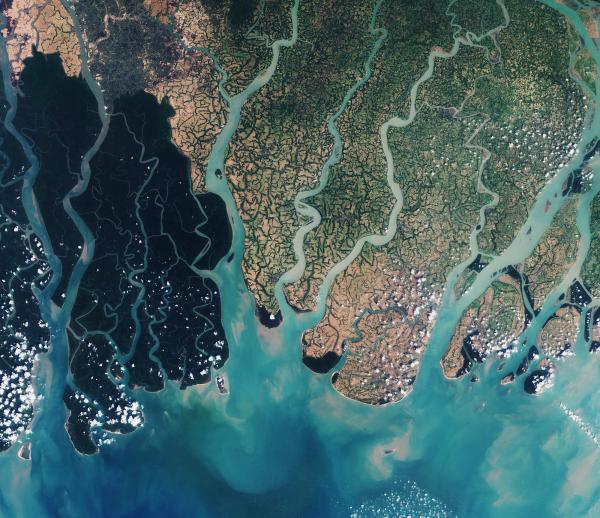Planning Students Advance to Nature-based Future Challenge Finals

This summer, two Community and Regional Planning students, Vickie Belcher (MSCRP ‘25) and Arfar Razi (MSCRP ’24), are participating in the final round of the Nature-based Future Challenge competition. Hosted by Wageningen University & Research in the Netherlands, the competition drew entries from around the world, including student teams from more than 140 universities in 45 countries. The competition tasked students to visualize the potential of nature-based solutions to respond to the effects of climate change and biodiversity loss in one of the most climate-vulnerable regions in the world, Bangladesh and the Bengal Delta.
Through two rounds of competition, Belcher and Razi’s team, Terraqueous—also comprised of members from the Bangladesh University of Engineering and Technology and Wageningen University and Research—advanced to the competition finals, hosted in the Netherlands on Tuesday, June 11. There, they’ll present their vision for Bangladesh as a model deltaic nation in 2121.
A key component of the competition is its multidisciplinary nature. With expertise across three universities (and countries) spanning disciplines and academic levels, the Terraqueous team tapped their diverse backgrounds and academic disciplines to harness nature-based solutions to build climate resilience via planning, environmental and climate justice, geospatial analysis, climate modeling, and innovative design and engineering.
“This project has shown me the valuable role of planners in helping to set a vision and empower expertise from diverse disciplines,” Belcher said. “In our case, our team is united by a shared vision that a terraqueous future where water, earth, and people all thrive is possible in deltaic Bangladesh. Working across disciplines and different countries, we’ve been able to push each other to reconsider existing ideas and create the best possible final product. Doing this, we’ve worked together for over seven months taking countless meetings across time zones and I’m so proud of what we’ve achieved as a team.”
In Terraqueous’ vision for 2121, Bangladesh will emerge as the world’s first developed terraqueous nation, where water and local knowledge drive climate resilience and sustainability, health, and economic prosperity. By harnessing the power of water and local knowledge, nature-based solutions will be co-created with communities. As part of the competition brief, the group honed in on the BDC Triangle megaregion, developing concrete initiatives and a detailed transition pathway for the area, which offers an actionable roadmap for Bangladesh to achieve its terraqueous vision.
For the BDC Triangle, which spans the Barisal, Dhaka, and Chittagong Divisions, Terraqueous proposed six High Leverage Points (HLPs) with 18 corresponding projects across micro, meso, and macro scales. Proposed projects range from household-level wetlands and floating health clinics to regional watershed management strategies and national circular economy policies, addressing specific challenges while leveraging the region’s ecological assets and community knowledge with each intervention.
During the finals later this month, the team will focus further on one of their proposed High Leverage Points: Green Circular Economy. They’ll present a detailed case study of a jute-based circular economy, illustrating how micro-, meso-, and macro-level interventions can work together to create a sustainable and thriving jute industry in Bangladesh.
In addition to the expertise of their international team members—Ignancio Andueza of Wageningen, and Nazmul Hoque Nayeem, Arefien Razi, Mahia Mustary Nushin, and Aqib Mohammad Nibir of Bangladesh University of Engineering and Technology—Belcher and Razi bring their own backgrounds and expertise to the challenge.
For Belcher, who recently completed her second year of the Master of Science in Community and Regional Planning, the competition aligns with her interests in water management and environmental justice. Through the CRP program, she has served as the UT Lead for APATX’s Legacy Project, researched salinity in the Lower Rio Grande River, and assisted Austin’s Watershed Protection Department with policy efforts. Belcher is extending her CRP program experience one extra year to participate in a Boren Fellowship in Bangalore, India, and conduct research aligned with her interests.
For Razi, a J. William Fulbright Fellow and a native Bangladeshi himself, the competition offers an opportunity to apply his expertise in environmental and land use planning. As a former lead geographic researcher at the Bengal Institute for Architecture, Landscapes, and Settlements, Razi developed methodologies for understanding urban areas with a hydro-geomorphic context. Following his time at UT Austin, Razi is back in Dhaka, facilitating decision-making in land use and environmental planning for deltaic cities, with the potential to inform global urban planning efforts.
"Participating in this challenge has been an incredible opportunity to apply the knowledge and skills I've gained through the Community and Regional Planning program at UT Austin,” Razi notes. “Our team motto, 'regional vision for flourishing communities', perfectly encapsulates what we strive for as planners - to develop thoughtful, multidisciplinary solutions that help communities thrive in the face of complex challenges like climate change. In this 10-month challenge, we developed a framework for the planning process that demonstrates how various stakeholders can engage and collaborate, addressing local issues and leveraging local resources to combat climate change and other anthropogenic challenges. Through this experience, we've had the privilege of working with a diverse group of passionate individuals from around the world to craft a bold vision for Bangladesh's future."
The Sundarbans comprising southern Bangladesh and a small part of the Indian state of west Bengal. Photo contains modified Copernicus Sentinel data (2016), processed by ESA: CC BY-SA 3.0 IGO.




